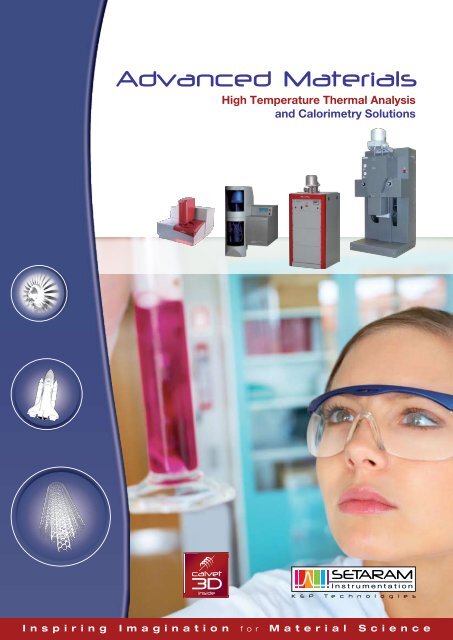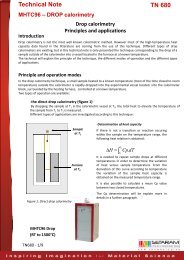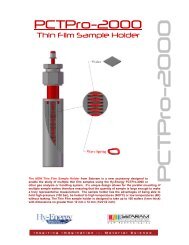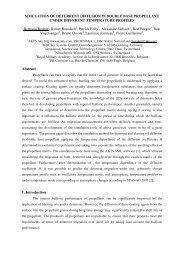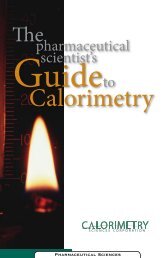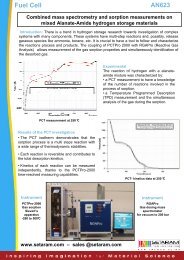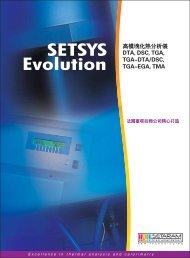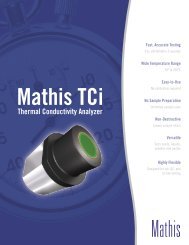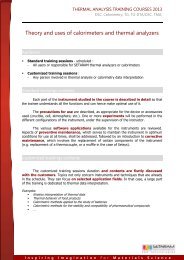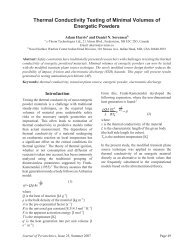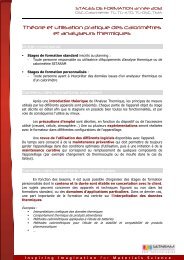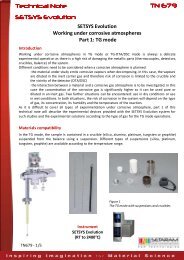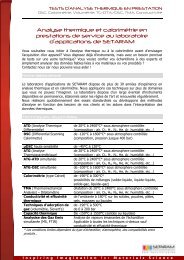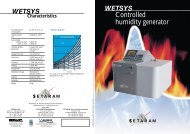Advanced Materials
Advanced Materials
Advanced Materials
You also want an ePaper? Increase the reach of your titles
YUMPU automatically turns print PDFs into web optimized ePapers that Google loves.
<strong>Advanced</strong> <strong>Materials</strong><br />
High Temperature Thermal Analysis<br />
and Calorimetry Solutions<br />
Inspiring Imagination for Material Science
Sintering techniques were first used for the<br />
preparation of ceramics, but are now also used<br />
for the development of high value alloys. Precise<br />
knowledge of a reliable and reproducible<br />
temperature profile is essential to the development<br />
of a quality sintered product. TMA allows<br />
for the measurement of sintering of even the<br />
finest powders under controlled atmospheres<br />
and non-linear and reactive temperature profiles.<br />
Oxidation and corrosion of materials in<br />
highly demanding applications is critical for<br />
long term performance of materials used in<br />
everything from re-entry vehicles to nuclear<br />
reactors and power plants. Using TGA under<br />
corrosive atmospheres, and with the ability<br />
to measure long isotherms it is possible<br />
to quantify the materials performance.<br />
Heat capacity (Cp) is one of the critical<br />
properties of a material that needs to be<br />
assessed. Cp can be estimated by DSC,<br />
however 3D Calvet based techniques provide<br />
higher precision measurement of Cp.<br />
For high temperature Cp measurement drop<br />
calorimetry is the most accurate alternative.<br />
Phase diagram and formation enthalpies<br />
of alloys and oxides are also essential<br />
thermochemical data for the understanding of<br />
materials compatibility and reactivity.<br />
They are obtained by using high temperature<br />
calorimetry in DSC or drop mode.<br />
2<br />
During the development of <strong>Advanced</strong> <strong>Materials</strong> it is essential to understand production<br />
challenges as well as to characterize the performance of a material under the most challenging<br />
and demanding experimental conditions. Setaram presents a comprehensive range of techniques<br />
and instrumentation for the <strong>Advanced</strong> <strong>Materials</strong> laboratory with the ability to quantify all types<br />
of behavior, including dimensional, mechanical, mass variation and phase changes under<br />
the most demanding of experimental conditions. Only Setaram can offer temperatures down<br />
to -196 °C and up to 2400 °C and also the ability to work under corrosive, oxidative, controlled<br />
humidity and high vacuum atmospheres.<br />
<strong>Advanced</strong> <strong>Materials</strong><br />
3
<strong>Advanced</strong> <strong>Materials</strong><br />
Our Products<br />
The LABSYS evo system is a highly flexible TGA / STA (Simultaneous Thermal<br />
Analysis) system that also offers a unique 3D Calvet based Cp rod for materials<br />
characterization up to 1600 °C. This highly flexible system features a powerful<br />
furnace, a thermostated balance designed specifically for thermal analysis<br />
applications and plug and play rod connectors for ease of use and rapid<br />
configuration for different applications.<br />
<br />
LABSYS evo<br />
Ambient to 1600 ° C •<br />
0.01 to 100 °C/min •<br />
0.2 μg, 0.02 μg balance resolution •<br />
20 g maximum balance capacity •<br />
Up to 3 carrier gases •<br />
TGA, DSC and DTA interchangeable rods •<br />
3D Cp rod for Cp measurements within 2 % •<br />
The SETSYS evolution is a high performance TGA / STA (Simultaneous<br />
Thermal Analysis) and TMA system designed for applications that demand<br />
the most challenging of experimental conditions. The heart of the system<br />
is Setaram’s unique symmetrical balance beam that allows for the direct<br />
suspension of even large sample sizes and a highly robust furnace that can<br />
operate all the way to 2400 °C and under the most aggressive atmospheres,<br />
from high vacuum, high humidity, reductive and oxidative atmospheres.<br />
Ambient to 2400 °C •<br />
SETSYS evolution<br />
TAG<br />
0.01 to 100 °C/min •<br />
TGA / STA (Simultaneous Thermal Analysis)<br />
0.03 μg / 0.3 μg balance resolution •<br />
35 g / 100 g balance capacity •<br />
TGA, DTA and DSC interchangeable rods •<br />
TMA<br />
Resolution to 0.2 nm •<br />
Zero force TMA capability •<br />
Controlled rate sintering •<br />
The TAG system from Setaram is the world’s most<br />
precise isothermal TGA system. It features the<br />
same symmetrical balance beam and aggressive<br />
atmosphere control seen in the SETSYS Evolution<br />
system. In addition it incorporates a pair of matched<br />
furnaces to achieve a truly symmetrical performance<br />
and therefore eliminate buoyancy effect.<br />
If you are studying long term corrosion and/or<br />
oxidation then nothing comes close to the TAG’s<br />
performance.<br />
Ambient to 1600 °C / 1750 °C •<br />
0.01 to 100 °C/min •<br />
35 g balance capacity •<br />
TGA, DTA and DSC interchangeable rods •<br />
The 96 line is a powerful modular system for<br />
the precise characterization of materials up to<br />
2100 °C using drop-calorimetry, DSC, DTA, TGA and<br />
TMA. The system is unique in that each module can<br />
use large, even bulky and heterogeneous samples<br />
to give data about materials in real life conditions.<br />
• Ambient to 2100 °C<br />
• TGA - samples up to 100 g<br />
• DSC - crucibles up to 450 μl<br />
• Drop calorimetry - crucibles up to 5700 μl<br />
• TMA - samples up to 18 mm diameter<br />
96 LINE<br />
Setaram offers a range of 3D Calvet High Temperature Calorimeters<br />
that are used for applications such as high precision Cp measurement<br />
and the study of alloy and oxide formation using drop techniques.<br />
The NEW AlexSys high temperature in-situ reaction calorimetry system is designed<br />
to measure heat of formation, heat of solution, Cp and other characteristics of actinides,<br />
oxide melts, and other materials. Its unique gas mixing system removes the need<br />
for mechanical stirring.<br />
• Up to 800 °C or 1000 °C<br />
• Vessel volume - 28 ml<br />
(quartz cell) or 20 ml<br />
(platinum crucible)<br />
C600 calorimeter is available for calorimetric<br />
measurements up to 600 °C.<br />
• Up to 600 °C<br />
• Cell Volume 8.5 ml<br />
ALEXSYS
Applications<br />
High Temperature DTA<br />
TMA/Dilatometry<br />
Low load and controlled SINTERING using SETSYS Evolution TMA<br />
The vertical setup of SETSYS Evolution TMA allows applying loads as low as 1 g. In the<br />
following example, a polyethylene-coated metallic powder was tested under different<br />
loads, in the controlled sintering mode. This mode consists in controlling the temperature<br />
of the sample so that sintering happens at a set rate.<br />
The thermogram below shows the heating of the sample between 25 °C and 1350 °C at 5 K/min,<br />
with a set load of 2 g. The sintering rate is set to 0.05 %/min. PE starts to melt at 124 °C, leading to<br />
a shrinkage of 2.36 %. The sintering starts at 868.5 °C.<br />
Phase diagrams in a wide temperature<br />
range: crystallization of a high-end<br />
application ceramic<br />
Yttrium aluminum garnet (YAG), in its neodymiumdoped<br />
form (Nd:Y 3Al 5O 12), is widely used in<br />
solid-state lasers. Nd- doped YAG lasers have<br />
biomedical applications in photocoagulation for<br />
patients suffering from ulcers, in correction of<br />
complications linked with cataract surgery, or in<br />
removal of skin cancers.<br />
They are also used for engraving, etching,<br />
or marking a variety of metals and plastics.<br />
They are extensively used in manufacturing<br />
for cutting and welding steel and various alloys.<br />
In the present example, a powdered sample of Nd:Y 3Al 5O 12 was placed in a tungsten crucible.<br />
It was heated up to 2100 °C under helium flow in a SETSYS Evolution equipped with a high<br />
temperature furnace and tungsten DTA rod. Then it was cooled down at a controlled rate<br />
of 20 K/min. The thermogram exhibits two crystallization peaks above 1900 °C.<br />
High Temperature Calorimetry<br />
Heat capacity (Cp) determination of glasses<br />
with MultiHTC (HF-DSC)<br />
Together with the other potassium feldspars,<br />
orthoclase (KAlSi 3O 8) is a common raw material<br />
for the manufacture of glasses, ceramics (such as<br />
porcelain) and is a constituent of scouring powder.<br />
Some intergrowths of orthoclase and albite have an<br />
attractive pale luster and are called moonstone when<br />
used in jewelry.<br />
A large sample (1040.22 mg) of orthoclase was<br />
heated from 300 °C up to 1500 °C at 10 °C/min in<br />
a multiHTC HF-DSC sensor. A blank and a reference<br />
tests then allowed calculating the heat capacity of the<br />
mineral, and detecting its glass transition temperature<br />
(972.8 °C) and melting (1 451.7 °C).<br />
The same test with 20 g<br />
load leads to an irreversible<br />
deformation of the sample<br />
High Temperature TGA<br />
High temperature oxidation / corrosion<br />
The symmetrical thermoanalyzer TAG was used to study the resistance of a metallic plate<br />
to corrosion at high temperature.<br />
The sample weight is measured under an oxygen flow (30 ml/min) at 1100 °C during a<br />
100 h experiment. The observed mass increase is due to surface oxidation of the sample.<br />
The outstanding long term stability of TAG thermobalance allows recording a very clear signal,<br />
even in the case of small mass change over a long period of time.<br />
Customer testimonial<br />
Heat of thermite reaction with MultiHTC<br />
(drop cell)<br />
During a thermite reaction aluminum reacts with an<br />
oxide of another metal, most commonly iron oxide<br />
Fe 2O 3. Although the reactants are stable at room<br />
temperature, when exposed to sufficient ignition<br />
heat, they burn with an extremely intense exothermic<br />
reaction and as a result aluminum oxide Al 2O 3 and<br />
iron are formed.<br />
Drop calorimetry is used to investigate this reaction:<br />
pellets of Fe 2O 3 + 2Al are dropped into a boron<br />
oxide crucible, placed at 1550°C, under an inert<br />
atmosphere. Calibration is done with sapphire.<br />
Knowing the heat of formation of Al 2O 3 and heat<br />
capacity of Fe 2O 3, the enthalpy of the thermite<br />
reaction can be easily determined.<br />
«At Saint-Gobain central research centres (in France and<br />
USA) - where we study glass, ceramics and other high<br />
performance materials - we have set up a laboratory<br />
to study the thermal behaviour of the various raw<br />
materials we use as well as our finished products. Our<br />
goal is to accurately characterize variations in CP (glass<br />
transition), crystallization, melting and/or any other phase<br />
transformation experienced by our materials during<br />
heating. The unique design of the 3D sensor of the Multi<br />
HTC Line 96 has enabled us to study high temperature<br />
phenomena with greater precision. SETARAM answers our<br />
needs in terms of reliability and robustness and provides us<br />
with the technical support necessary for the development<br />
of procedures customized for our specific materials.»<br />
Sophie PAPIN - Groupe Minéralogie Appliquée<br />
Service Expertises Analyses Réfractaires- SAINT-GOBAIN RECHERCHE - France
Some International references<br />
Air Liquide - France<br />
Alstom - Switzerland<br />
BAM (Bundesanstalt für Materialprüfung) - Germany<br />
BARC (Bhabha Atomic Research Centre) - India<br />
Brookhaven National Laboratory - USA<br />
Cambridge University - UK<br />
CEA Saclay - France<br />
Chimie ParisTech - France<br />
CIEMAT - Spain<br />
CMTR (Chimie Métallurgique des Terres Rares) CNRS - France<br />
Cogne Acciai Speciali - Italy<br />
CSIC - Instituto Cerámica y Vidrio - Spain<br />
CSIRO - Australia<br />
CTTC (Centre de Transfert de Technologies Céramiques) - France<br />
Endesa - Spain<br />
ICMMO (Institut de Chimie Moléculaire et des Matériaux d’Orsay) - France<br />
IFP (Institut Français du Pétrole) - France<br />
IGCAR (Indira Gandhi Centre for Atomic Research) - India<br />
IIT (Illinois Institute of Technology) - USA<br />
JAEA (Japan Atomic Energy Agency) - Japan<br />
Johnson Matthey - UK<br />
JRC (Joint Research Centre / European Comission) - Germany<br />
KAERI (Korea Atomic Energy Research Institute) - South Korea<br />
KIMS (Korea Institute of Machinery & <strong>Materials</strong>) - South Korea<br />
Kyoto University - Japan<br />
LCSM (Laboratoire de Chimie du Solide Minéral) - Université Henri Poincarré - France<br />
Lockheed Martin - USA<br />
MINES ParisTech - France<br />
NIMS (National Institute for <strong>Materials</strong> Science) - Japan<br />
NRC (National Research Council) - Canada<br />
NSTR (Nippon Steel Technoresearch Corporation) - Japan<br />
Nuclear Fuel Industries, Ltd. - Japan<br />
Oxford University - UK<br />
Saint Gobain High-Performance <strong>Materials</strong> - USA<br />
Saint-Gobain Recherche - France<br />
Sheffield Hallam University - UK<br />
Snecma - France<br />
Standford University - USA<br />
Thales R&D - France<br />
TU Bergakademie Freiberg - Germany<br />
TU Clausthal - Germany<br />
Universität Wien - Austria<br />
University of California, Davis - USA<br />
Veolia Environnement - France<br />
Offices in United Kingdom, Germany,<br />
Italy, Switzerland and Singapore<br />
w w w . s e t a r a m . c o m<br />
sales@setaram.com<br />
SETARAM INSTRUMENTATION<br />
7 rue de l’Oratoire<br />
69300 Caluire - France<br />
Phone +33(0)4 72 10 25 25<br />
Fax +33(0)4 78 28 63 55<br />
SETARAM Inc.<br />
8430 Central Ave. Suite C<br />
Newark, CA 94560 - USA<br />
Phone +1 (510) 793 3345<br />
Fax +1 (510) 402 4705<br />
SETARAM China<br />
Rm.201, Building D, Block 7,<br />
No.128 Huayuan Rd,<br />
Shanghai 200083 – PR China<br />
Phone: +86 21 36368319<br />
Fax +86 21 36368094<br />
PIRANA.net • Specifications are given as indications only and are not contractual • 03/10<br />
Inspiring Imagination for Material Science


